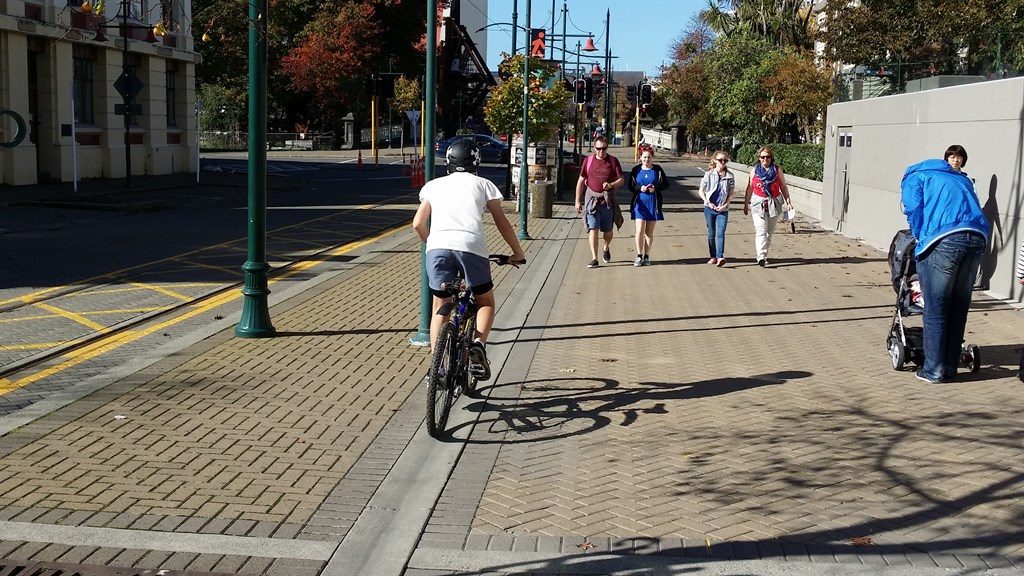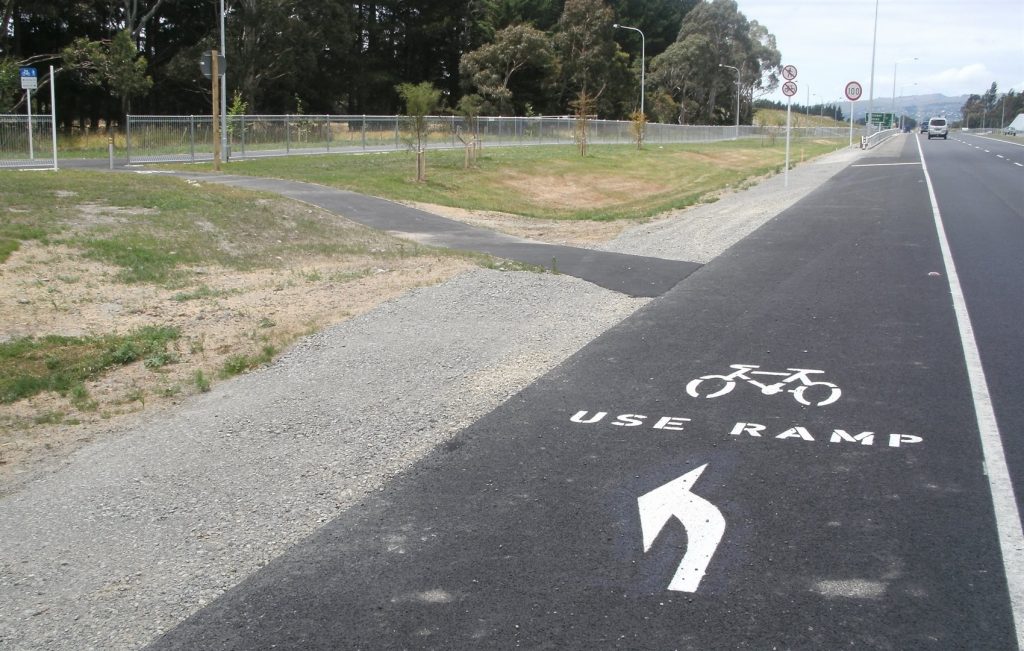As we roll out more cycleways and other facilities around the city, it’s probably timely to remind everyone where you can and can’t bike and the Road Rules around them. Mind you, that could all change before we know it; there are a few proposed transport legislation changes still going nowhere fast on the Transport Minister’s desk that could affect some of these things. But for now, here’s the current state of play (as first posted in Dec 2015)…
Having previously covered the innocuous legal question of what exactly constitutes a bike, we’ll now turn our attention to where exactly you can ride your bike (and some of the implications of that). Before we get too far into that, it’s helpful to understand two key definitions in NZ legislation:
- A “road” has a very broad definition in land transport rules here. As originally defined in the Land Transport Act 1998, a road includes “a street; a motorway; a beach; a place to which the public have access, whether as of right or not; all bridges, culverts, ferries, and fords forming part of a road or street or motorway; and all sites at which vehicles may be weighed for the purposes of this Act or any other enactment.” Thinking about that definition seems to include an awful lot of places – is your local park a “road”? What about a public library? {Apparently it can be: a person who once rode their motorcycle onto an escalator in the old Christchurch Central Library was charged with a driving offence!} NZ Transport Agency have tried to help clarify just what a “road” means, although it may still leave a few questions to be tested in court one day. The definition is deliberately quite broad so that road rules can control behaviour of drivers and vehicles in places other than your garden-variety street (e.g. you could probably be charged with reckless driving for hooning around people in your car in the middle of a busy sports-field) – it doesn’t however mean that you have free access to actually drive (or ride) in all of these places (e.g. you still can’t generally drive on a lawn or garden forming part of a “road”).
-1024x455.jpg)
- A “roadway” meanwhile is defined as “that portion of the road used or reasonably usable for the time being for vehicular traffic in general.” In simple terms, the distinction usually boils down to: the “roadway” is the bit between the kerbs and the “road” is the bigger bit between the fence-lines (property boundaries). Many rules about intersections, turning, passing and parking refer to behaviours that occur on roadways, not roads.
Taking on board those definitions, here are a few interesting rules relating to where you can cycle (or not):
- As I mentioned above, just because something is considered part of a “road” doesn’t automatically mean you can ride there. For example, use of an ordinary footpath (or grass berm) is prohibited on a bike unless you are delivering material like newspapers {I have heard of people carrying some printed material with them when biking, in case they get stopped on a footpath by a cop…}. Despite the common mis-perception, children are not allowed to bike on footpaths either (that rule applies in Australia), unless their bike is so small that it is classed as a “wheeled recreational device” instead. In practice, the Police tend to turn a blind eye, especially if kids are riding slowly and carefully.

-

Shared Path sign It is only on signed/marked shared paths (i.e. for pedestrians and cyclists) that you’re allowed to ride freely off-road; even there all path users still have an obligation to use it in a “careful and considerate manner”, e.g. you can’t create a hazard for other users or unduly impede their passage. Shared paths should be denoted by either signage or markings that show both cycle and pedestrian symbols (Christchurch City Council is even now going to the effort to record shared paths in their Traffic Bylaw as well; not entirely sure if that is necessary). Although not common practice here in Christchurch, in some parts of the country you may encounter signs that indicate separate parts of a path for those walking and cycling, or that indicate a priority of one group over the other (although everyone still has an obligation not to impede others, regardless of any priority).
- One of the current headaches in NZ is determining what category a separated cycleway falls into (i.e. separated by a kerb, posts, or something similarly physical) – are they part of the roadway or are they behind the roadway like a footpath? This has some implications for situations like side-roads; if you are considered on the roadway then (like ordinary motor traffic) you have priority over side-road traffic, but if you are considered off it then (like a person on a footpath) you would have to give way to side-road traffic. Some legal interpretations suggest that the latter is the current case in NZ law, which is not really intended for many new cycleways, so there is some work going on behind the scenes to tidy up and clarify this legislation. In the meantime, for now, don’t necessarily assume that you have right of way on separated cycleways at side-roads (but you do have right of way when crossing driveways).
- The mandatory bike helmet rule in NZ applies to “roads” (not roadways) so, yes, that does technically mean you need to be wearing it in the middle of Hagley Park or along the beach (whether a Police officer would bother ticketing you there is another matter…). I’ve seen a few people who seem to be trying to avoid the problem of not having a helmet by riding on the footpath – unfortunately for them they’re now technically up for two offences; footpath riding and helmet-less riding…
-

No cycling allowed here Motorways are the common exception to general access to roads for bikes; the Government Roading Powers Act 1989 generally prohibits bikes from operating there (although intriguingly it does allow the possibility that their operation can be approved on certain sections of motorway). Other places that might prohibit cycling (e.g. certain “expressways”) are usually indicated by signs, but that restriction does need to be backed up with an accompanying bylaw by the relevant roading agency. {Interestingly, despite having “No Cycling” signs along QEII Drive and Anzac Drive, I’m not aware of any actual current legal restriction for on-road cycling along this route, as NZTA didn’t carry over the bylaw when they took it over as a State Highway from Chch CC…}
- So, what if there is an on-road cycle lane or off-road cycle path – do you have to use them? The short answer is no, you are completely free to determine where it is best to ride for yourself (e.g. to turn right, get past pinchpoints, or to avoid pedestrians). Bear in mind of course that you still have an obligation not to unduly impede other traffic (and we all know that some motorists get very antsy when some riders don’t use “their cycleway”…). One exception is with previously-mentioned prohibited roads like motorways, where you are likely to be directed onto a pathway at the start that you have to use. Conversely, motorists are not allowed to drive in cycle lanes, unless they are crossing them or avoiding an obstruction, and even then they have to give way to any bikes there first.

That in a nutshell sets out your rights in regards to where you can bike – sometimes it’s where motor traffic is, sometimes it’s where pedestrians are, and sometimes it’s in your own dedicated space. In the next legal issues segment we’ll look at what kind of equipment and other things you can (or must) have with your bike. As always, I also welcome feedback on other legal things you’d like to know about cycling.
Do you have any legal questions about cycling in NZ? Contact us!

-1200x533.jpg)
Heading east on Blenheim Rd as it approaches curletts Rd intersection the cycle way shrinks and the last 50m to the intersection is supposed to be on the footpath before continuing on the road, I always stick to the road, a few weeks back someone deliberately pulled into the gutter so I couldn’t pass inside there were 4 cars in front waiting on a red light I sailed by on his right unfortunately he yelled something about cycle lanes as I went past. After three 12 hour shifts in a hot factory and fighting a horror easterly on my home commute that was the straw that broke the camels back. I circled back and explained the rights and wrongs of The cycle road code in (in layman’s terms)… He looked a little startled